In 2022, the demand for web applications has increased with more and more businesses employing them to deliver a better user experience. Looking at this rising demand, developers are continually testing different frameworks that offer advanced features to build web applications. According to the Node.js user survey report, 4 out of 5 back-end and full-stack developers rate Node.js frameworks as their go-to choice.
They offer software engineers unique toolsets to develop different use cases without wasting time or burning extra cash for web app development. However, when a technology is as popular as Node.js, it normally has an active community of developers constantly developing and suggesting new frameworks.
Therefore, choosing the right framework can be tough especially when there are so many. Some will offer development freedom; others may support automation.
In this blog, we present a list of the top 10 most popular Node.js frameworks based on their popularity and usage among developers. Also discussed are the whens and whys of their usage to perform specific tasks during web-app development.
Is Node.js a Framework?
There is a longstanding debate about whether Node.js is a framework. Well more often than not, we do refer to it as one. However, Node.js is actually a JavaScript runtime environment — a platform to execute JavaScript codes on the server-side and make it portable. In layman’s terms, a runtime environment is where developers run a program.
In contrast, frameworks are used to build functions. Many developers have written frameworks for Node.js like Express.js, Meteor.js, and other tools to create unique capabilities for Node.js apps offering convenience to software engineers.
What are Node.js frameworks?
Every web-app technology offers different kinds of frameworks with each one supporting a specific use case in the development lifecycle. Node.js frameworks are mainly of three types — MVC, Full-Stack MVC, and REST API frameworks.
MVC frameworks
These frameworks offer a valuable design pattern that splits application logic into three essential parts: models, views, and controllers. Separating development concerns makes it extremely simple to maintain and scale the app. Express.js is a classic example of an MVC framework.
Full-stack MVC frameworks
When building a realtime app, Full-Stack MVC frameworks offer a great deal with scaffolding, libraries, template engines, and a range of other development capabilities. Additionally, they can take care of both frontend and backend development of applications.
REST API (Representational state transfer)/ REST API frameworks
Node.js frameworks have a firm reference to building apps faster with a ready and well-known REST API built experience. This means you don’t have to worry about the architectural styles of network applications.
Nearly all these frameworks provide a ready programming interface, which saves much time in development to build apps requiring an internet connection.
Trends: Most Popular Node.js Frameworks
According to Node.js web survey report 2018, Node.js has increased developer productivity by 68%, reduced development costs, and enhanced app performance to a great extent. This is a result of successful adoption and deployment of node.js frameworks.
Looking at the trends, Express.js, which positions itself as a minimalist and unopinionated framework, is the most popular framework boasting over 43,000 Github stars. Second in the list is Meteor.js, which specializes in building real-time chat and large scale applications with over 40,000 Github stars.
Looking at the current development needs, CTOs are leaning towards frameworks that help them minimize resource consumption and reduce marketing time.
Frameworks like Express, Meteor, Nestjs, Total.js are leading this trend with characteristics most suited for the development needs of 2024.
Top 12 Best Node.js Frameworks
Express.js– Express for Everyone
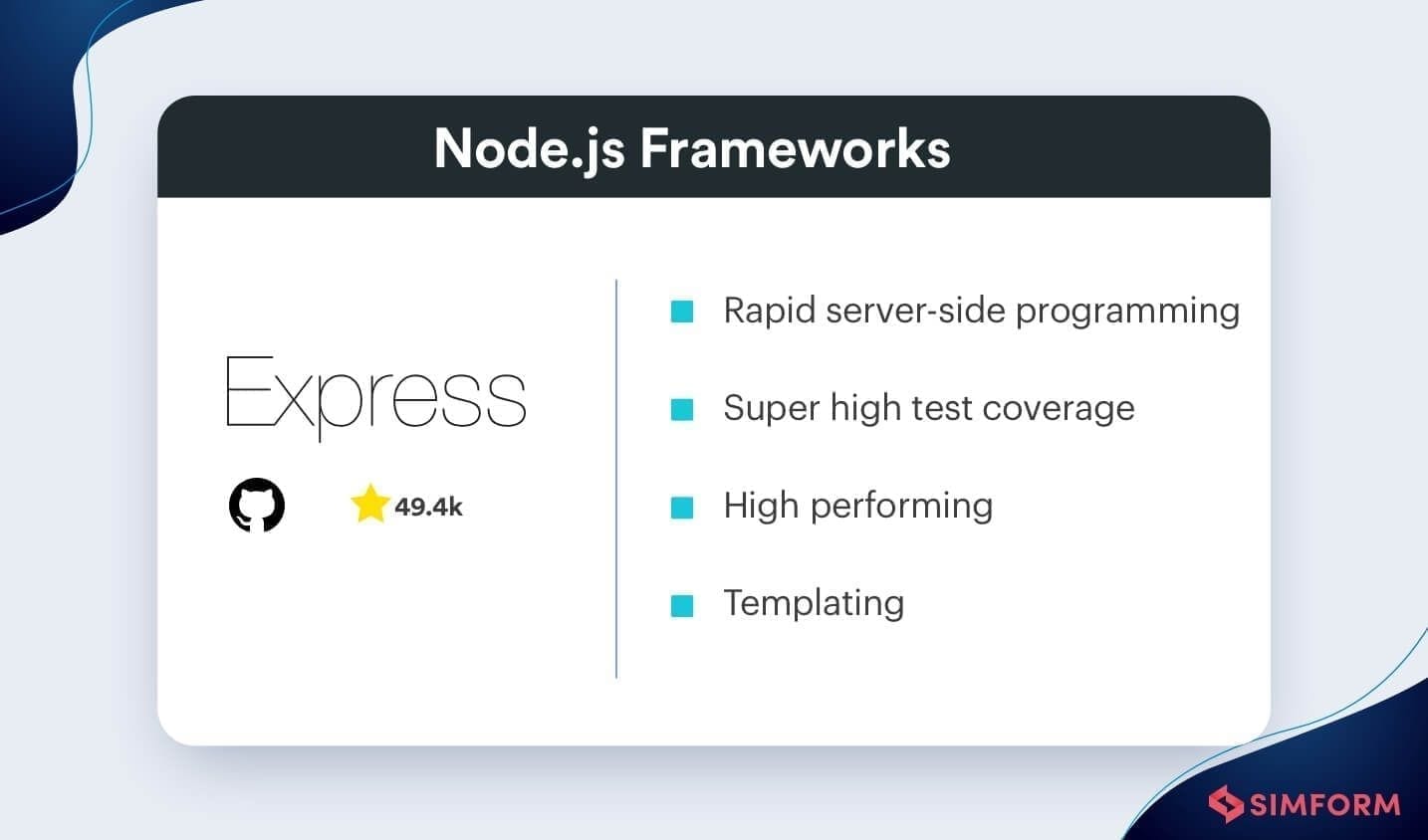
Express.js, aka Express, tops the list of best Node.js frameworks. It has a minimalistic approach and seems to be a classic and straightforward framework for coding architecture. Officially launched in 2010, it has been called the de facto standard for Node.js under the MIT license.
It does not require you to go steeper in the learning curve; instead, just a basic understanding of Node.js environment and programming skills suffice. Its fast, robust, and asynchronous architecture jives well with Node.
Express aligns with high-speed I/O operations and single-threaded nature of Node making it a default requirement for apps built with Node.js platform.
A more robust Application User Interface(API) means a more streamlined form of client-to-server requests and visible user interactions. Using Express, these software engineering principles are well executed.
Improving communication between client and server provides a thoroughly enjoyable experience to a web or mobile user. Companies like Twitter, Uber, Accenture, and other tech giants like IBM deploy applications built with Express.
Express offers some powerful features that take backend development to the next level.
Features:
- Rapid server-side programming packages- the framework has many Node.js features as functions and speeds up the process with few code lines.
- High performance- multiple operations are executed independently of each other using asynchronous programming
- Super-high test coverage helps build applications with maximum testability.
- A myriad of HTTP helpers- they make programs more intelligible, reusable.
- Better content negotiation- this helps in better communication between the client and server by providing HTTP headers to URLs, which fetch the exact information for the users/client-side.
- MVC Architectural pattern
When to use Express.js
You can develop web apps faster with the framework since it has almost readily available grounds for API generation. You can use it for any enterprise-grade or browser-based app because of its robust routing, templating, security features, and error handling provisions.
In fact, it’s quite suitable for almost any kind of web and mobile application development from small to large scale. For development teams at beginner levels, Express is the best choice since there’s outstanding community support available for this framework.
The following framework is- Koa.js. It’s being hailed as the next generation Node.js framework, so let’s see what it has to offer for modern-application development.
Koa.js- Next Generation Node.js Framework
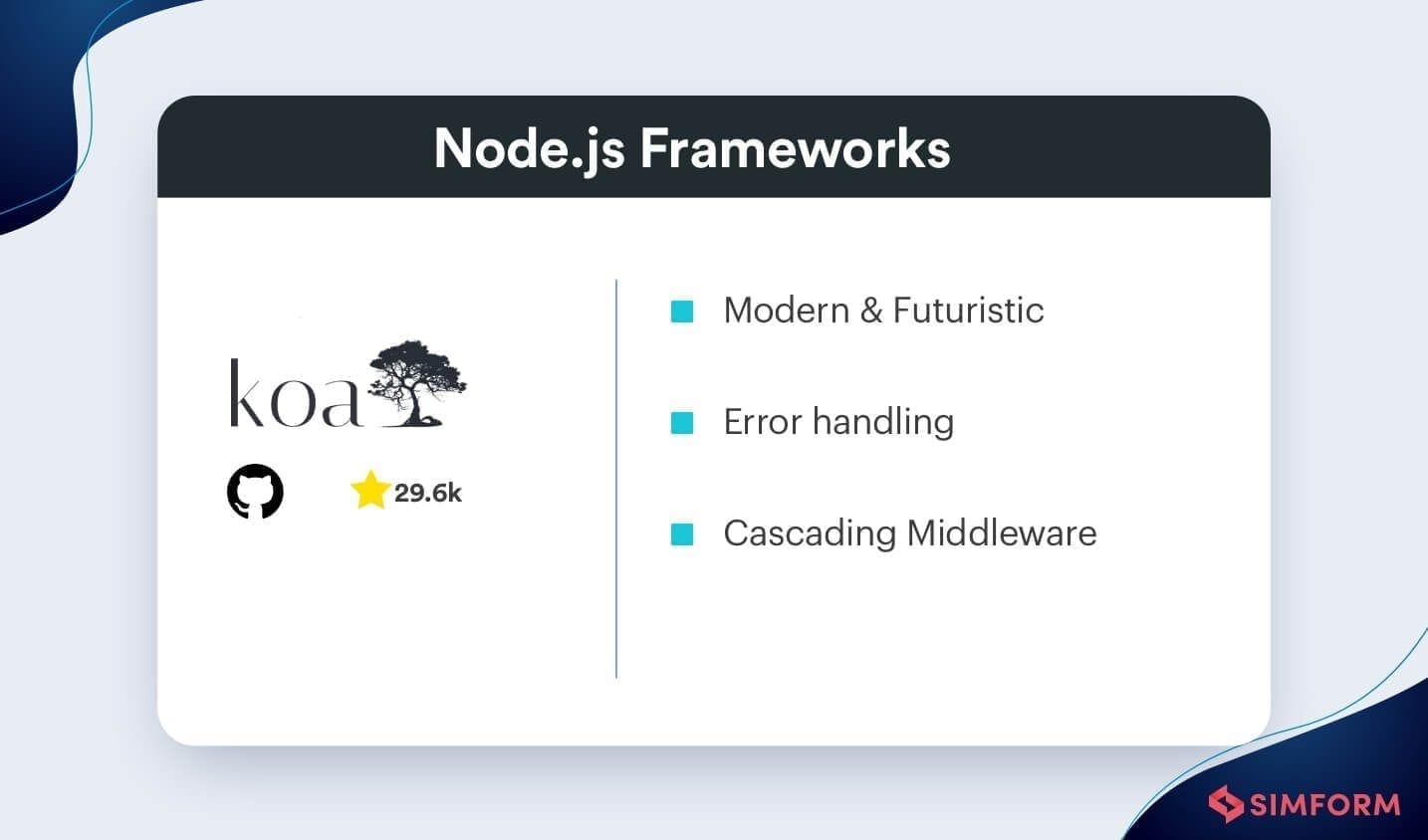
One of the more dominant Node.js frameworks, Koa works wonders creating different web services, aka APIs. With Koa, building these APIs becomes super fun and easy since it can efficiently deal with HTTP middleware with a stack-like method.
Further, it normalizes Node flaws constructively. You can maintain various forms of the content represented to the users with the same URL like translating a page, personalizing content in eCommerce websites, having different formats for images, and much more with this framework.
Another perk of using Koa is that it’s quite similar to Express. You can still enjoy the flexibility of Express with more freedom and fewer complexities while writing code. This minimizes the scope of errors across the entire stack of the application.
Features:
- Is a Customizable & Futuristic framework- is referred to as a lightweight version of Express
- Handles errors exceptionally
- Has cascading middleware (Personalizing user experience)
- Normalises node inconsistencies clean and helps in maintaining code
- Cleans cache, supports proxy and content negotiation
- Has more options for Customisation; allows building apps from scratch
When to use Koa.js
When performance is a critical demand from your web application, Koa is what you need. Especially for a big project, the framework can build extensive apps with large and experienced development teams. Under certain circumstances, Koa has proven to be a faster framework than Express.
However, it may seem to be a difficult choice for beginners because it’s still in the growth stages with the community and is less popular as a result.
Meteor- js– One Application, One Language
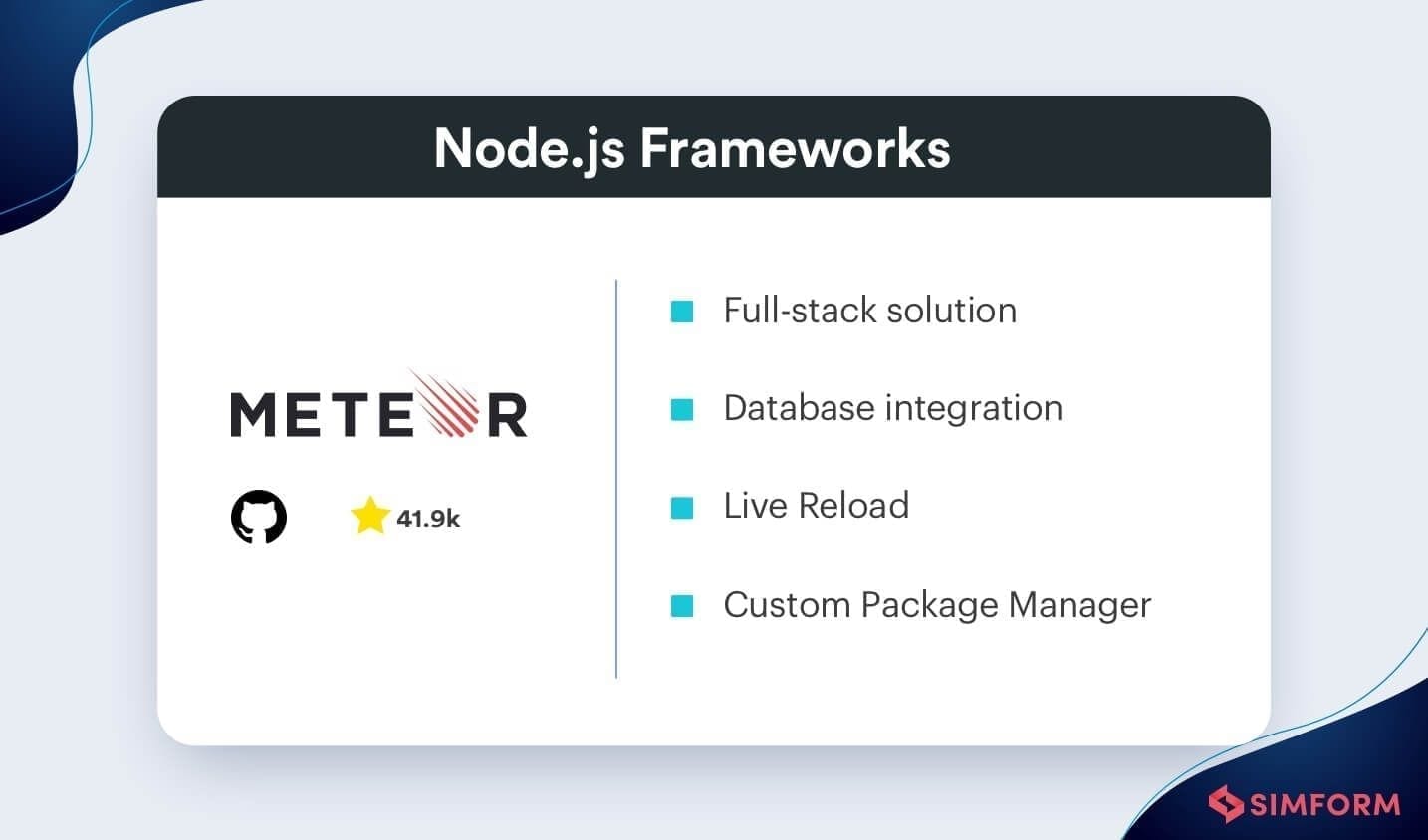
If you are looking for a framework that is specific to Javascript and uses only one language, Meteor.js is the ideal pick.
Officially launched in 2012, startup software, Meteor, developed Meteor.js — an open-source, isomorphic, Javascript web framework. It propagates automatic data changes to clients without developer’s efforts. Most importantly, it’s comfortable with variants of device-operating systems including Android, iOS for mobile devices and desktop applications all wrapped in one language- Javascript.
Meteor has comprehensive libraries and testing features to keep up with the client-server communication. The framework is known for its smooth running of data between client and server, which most applications of high-streaming, real-time functionalities require.
Meteor is a perfect Node.js framework to build simple, efficient, and modern web applications.
Features:
- Writing of code in modern JavaScript, Isomorphic framework
- Cross-platform framework, building rapid prototyping with CLI
- Extensive community support, open-source framework
- Full-stack solution
- Superfast interactions – fast results
- Easy integration with other frameworks
When to use Meteor.js
If your development team is good to go with Javascript, Meteor.js is a splendid choice. It is very easy to learn and super fun to program in. You can use it to build apps in no time since the framework allows you to use the same code written for a web app or mobile app. With Meteor, you can also deploy live updates even on the installed apps without disrupting an on-going user session.
Also, did I mention? The framework builds real-time applications with its built-in core. Without a doubt, it’s a perfect solution for collaboration with real-time app projects, short deadlines, and cross-platform
Check how we build SentMap - a real-time sentiment-based market analytics tool using Node.js
Socket.io- Chat Apps Made Easy with Socket.io
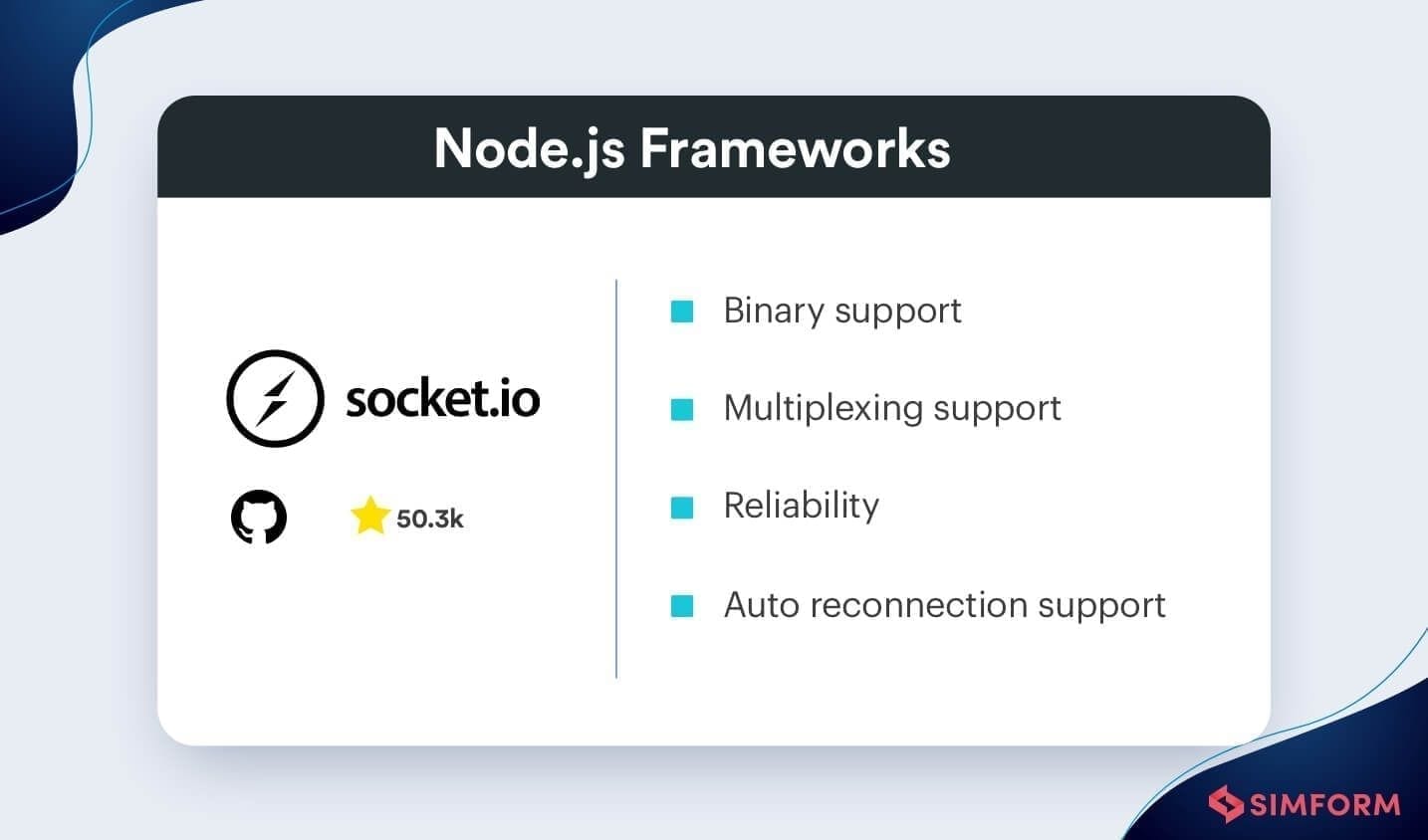
Whileproducts. all these real-time apps are connected and have the essential feature of real-time updating of responses and requests, we need Socket.io to configure the functionality.
Socket.io is a Javascript library used in building real-time apps and establishing bidirectional communication between web clients and servers. With this library framework, you can develop applications with requirements for websocket development. For example, chat applications like Whatsapp continuously run for live updates and refresh the background process for updates or messages. It also offers real-time analytics in fewer lines of code.
More than a thousand companies, including Bepro, Barogo, and Patreon, use Socket.io.
Features:
- Binary support (with a client-side library and a server-side library)
- Multiplexing support
- Reliability
- Auto-reconnection support
- Error detection & auto-correction
- Similar APIs for a client and server-side development
When to use Socket.io
Socket.io develops real-time applications like chat room applications, video conferencing apps, multiplayer games, and others, where servers are required to push the data without being requested from the client side. For example, live video calling apps like Zoom need to communicate real-time bidirectional data to several participants and Socket could come in handy with similar apps.
Our next pick is about building enterprise apps with double productivity since it has the best compatibility with frontend framework Angular — the Nest.js.
Nest.js– A Nestling of Code
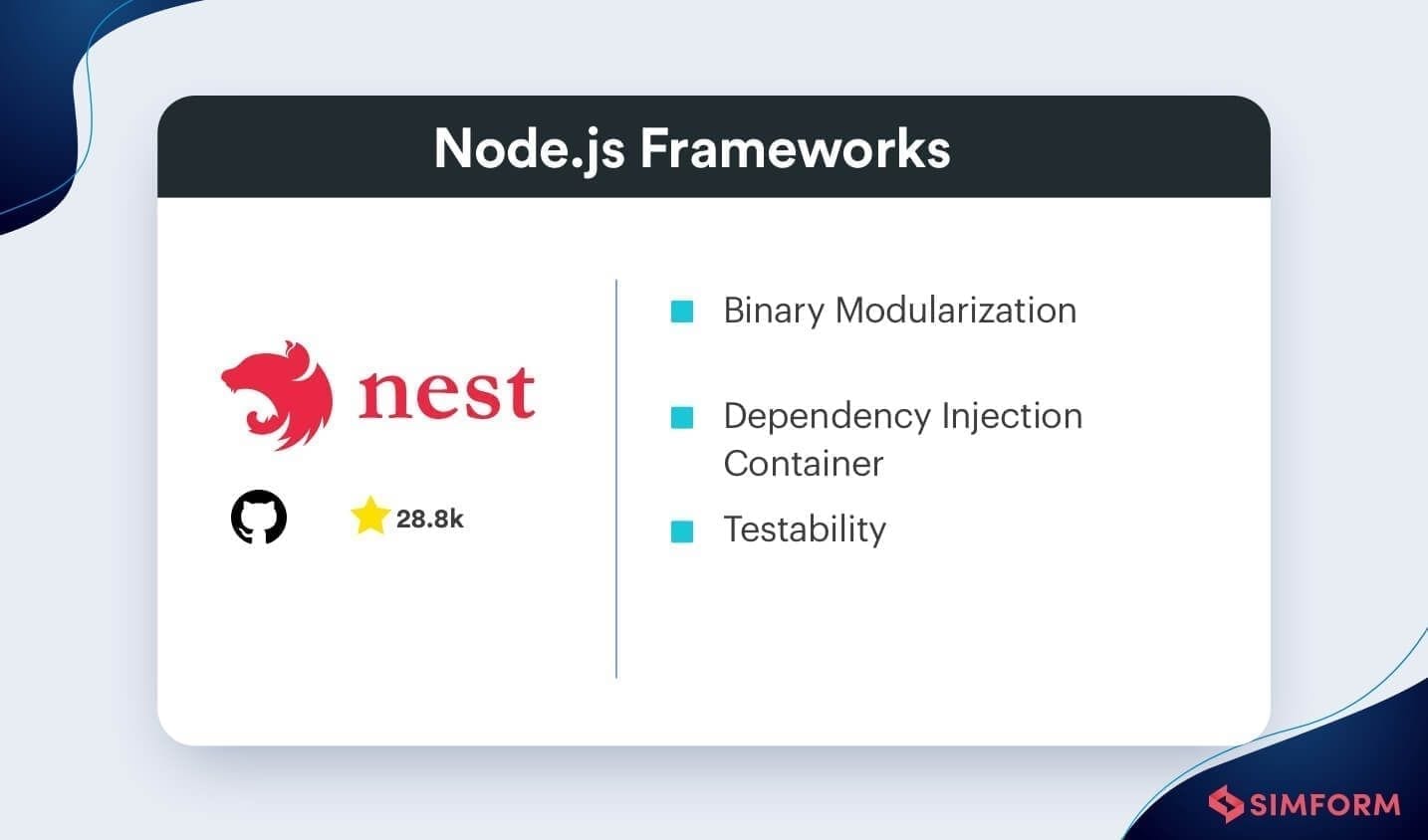
This is a progressive Node.js framework building dynamic and scalable enterprise-grade applications and offering complete flexibility with its extensive libraries.
It’s a perfect example of a backend productivity booster. You can use this framework to build multilayered enterprise applications since Nest.js won’t stop you from the extensive use of its libraries.
Because the framework preserves compatibility with a subset of Javascript (i.e., built with Typescript), it sticks to the clean-code architecture while maintaining the code complexity of large-scale applications. Moreover, nest offers excellent integration with sister frameworks like Fastify and Express.
Nest is the best combo of object-oriented and functional reactive programming(FRP). Hence, it potentially doubles developers’ productivity and application performance while saving valuable time.
Features:
- CLI for a modular structure & features
- Smooth learning curve
- FRP to simplify complex graphical user interfaces (ex. games, robotics)
- Easy-to-use external libraries due to systematic code arrangement
- High compatibility with Angular on the frontend
When to use Nest.js
Nest.js builds efficient and scalable web applications. Since it’s written with TypeScript much like Angular, the framework solves the main problem of Node.js.
It organizes the architecture pattern and keeps it clean and modularized helping developers build more scalable, and easily maintainable applications.
Sails.js- Modernized Data-Oriented MVC Framework
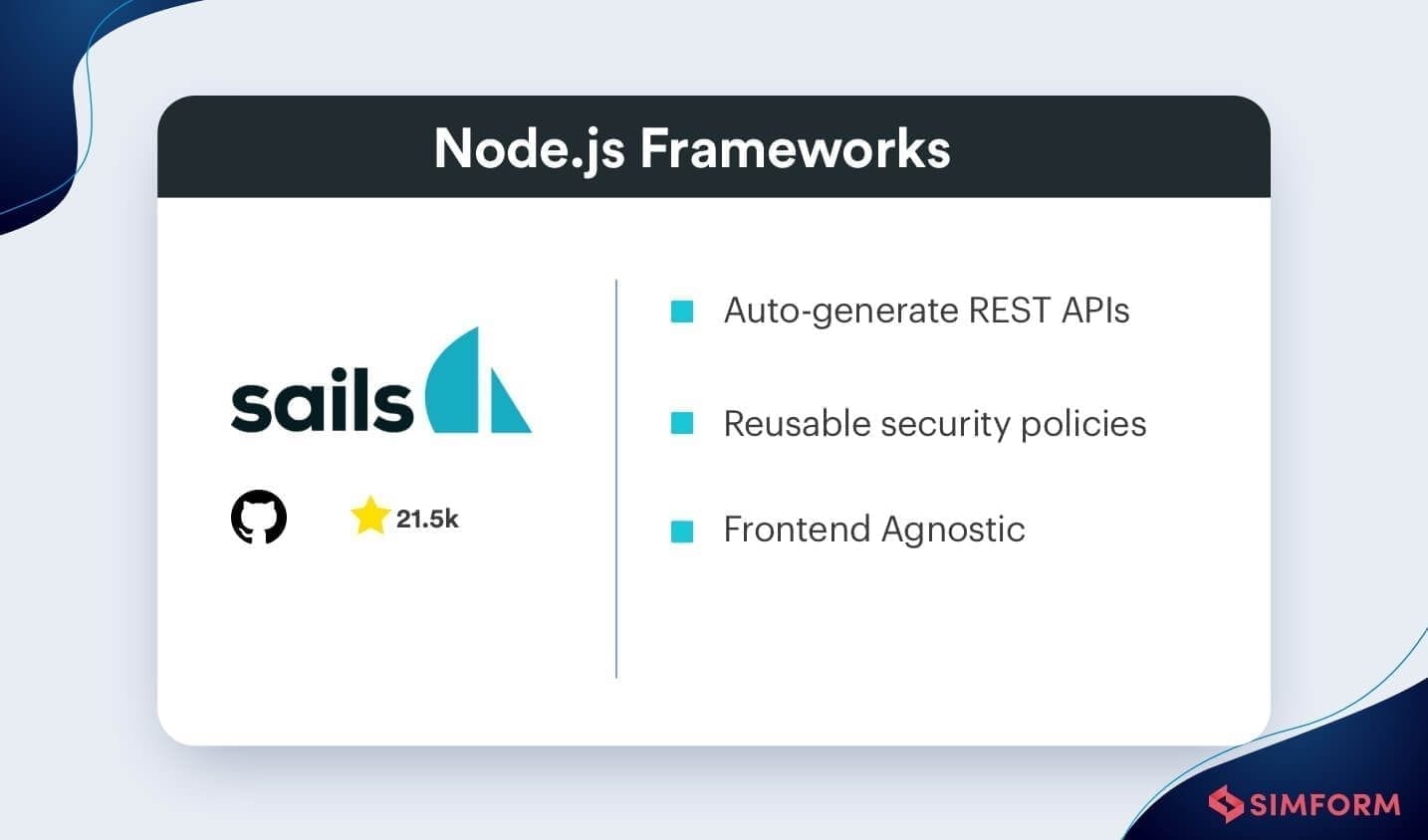
Sails.js resembles the MVC architecture pattern from frameworks like Ruby on Rails and provides support for modernized, data-oriented development. It is compatible with all databases and flexible in integrating Javascript frameworks.
Hence, it’s the most suitable framework to build high-end customized applications. Its specific code writing policies help in reducing the amount of required code allowing integration with npm modules by being more flexible and open.
Sails is a frontend-agnostic-backend platform. However, this lightweight framework uses Express for HTTP requests and Socket.io for WebSockets.
Plus, you can share the same API used by another web service or development team, which again saves time and effort.
Features:
- Auto-generate REST APIs
- Reusable security policies
- Frontend Agnostic
- ORM (Object Relational Mapping) for framework compatibility with databases
- Integration of Express for HTTP requests and Socket.io for WebSockets
When to use Sails.js
Owing to its accurate, streamlined data and reusable-middleware functions, you could build customized chat applications with this framework.
It has excellent compatibility with Socket.io making it a suitable integration for gaming and social media apps. Sails.js is preferably used for custom, enterprise-scale Node.js applications.
It can build production-ready apps in weeks and resembles Ruby on Rails MVC architecture pattern. However, developers might not prefer it for small apps.
This is because Sails has some flexibility limitations when it comes to high-end customization like with Express.
Total.js– A Complete Framework
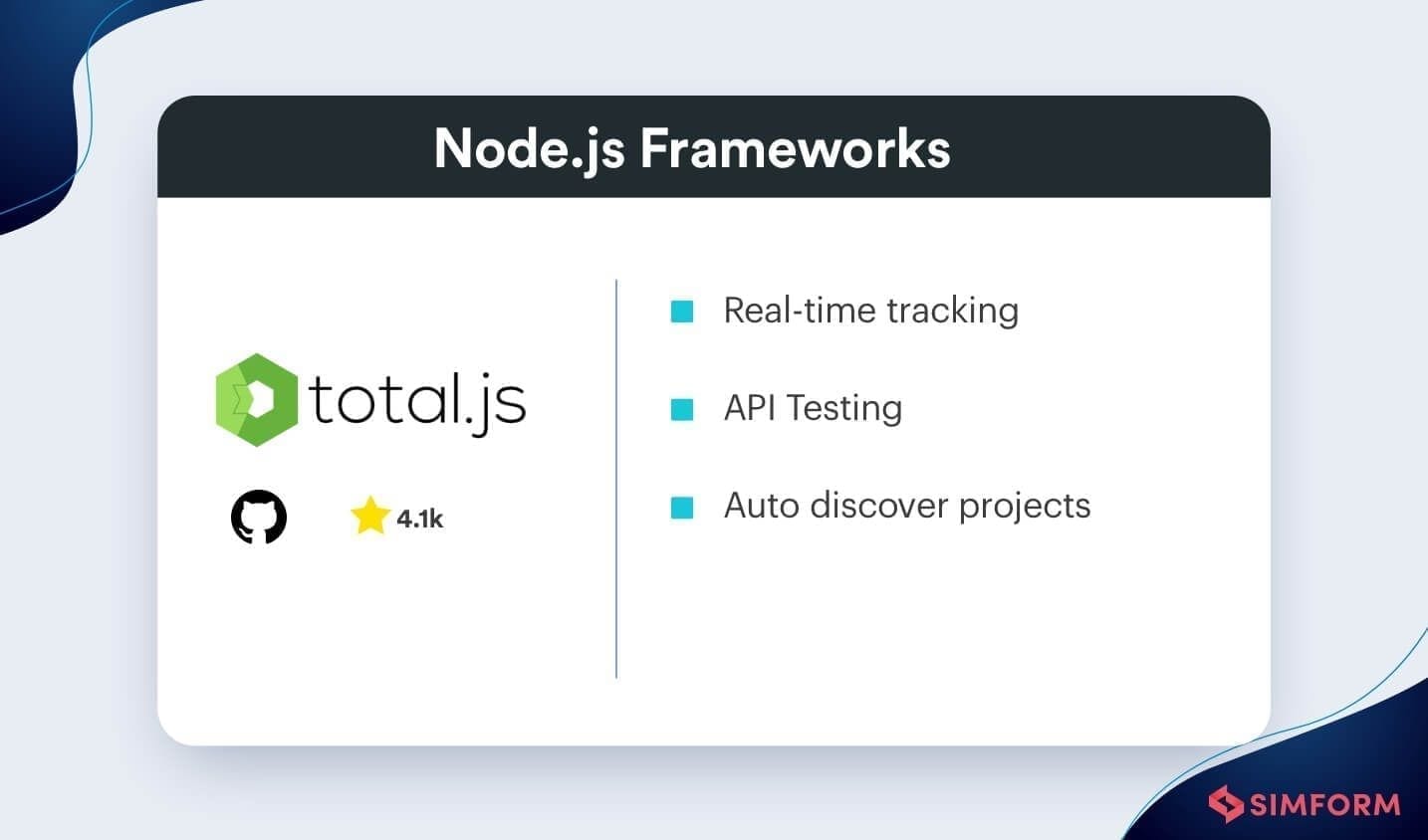
Among all these frameworks, Total.js is the only one that offers CMS-like experience and has pretty much everything you need in a Node.js environment.It’s a full-fledged open-source framework granting maximum flexibility to developers.
The framework is available in different versions, such as Eshop, CMS, and HelpDesk. With the help of these variants, your application has wider scope in future for the Internet-of-things integrations, REST service, and super-fast applications with low maintenance costs and stable service.
The framework is best known for its accurate real-time tracking in modern apps.
Features:
- Real-time tracking
- API Testing
- Auto-discover projects
- Multiple-database compatibility
- Flexible with different frontend frameworks
- Speedy development & low maintenance cost
When to use Total.js
Total.js is a complete framework for customized development, visual programming interfaces in the Internet of Things, eCommerce web development, cloud services, and real-time collaboration among other things.
If you need to develop apps within a steep deadline,say Total.js can help you speed up the development and prevent monetary loss.
Hapi.js- Secure than Ever
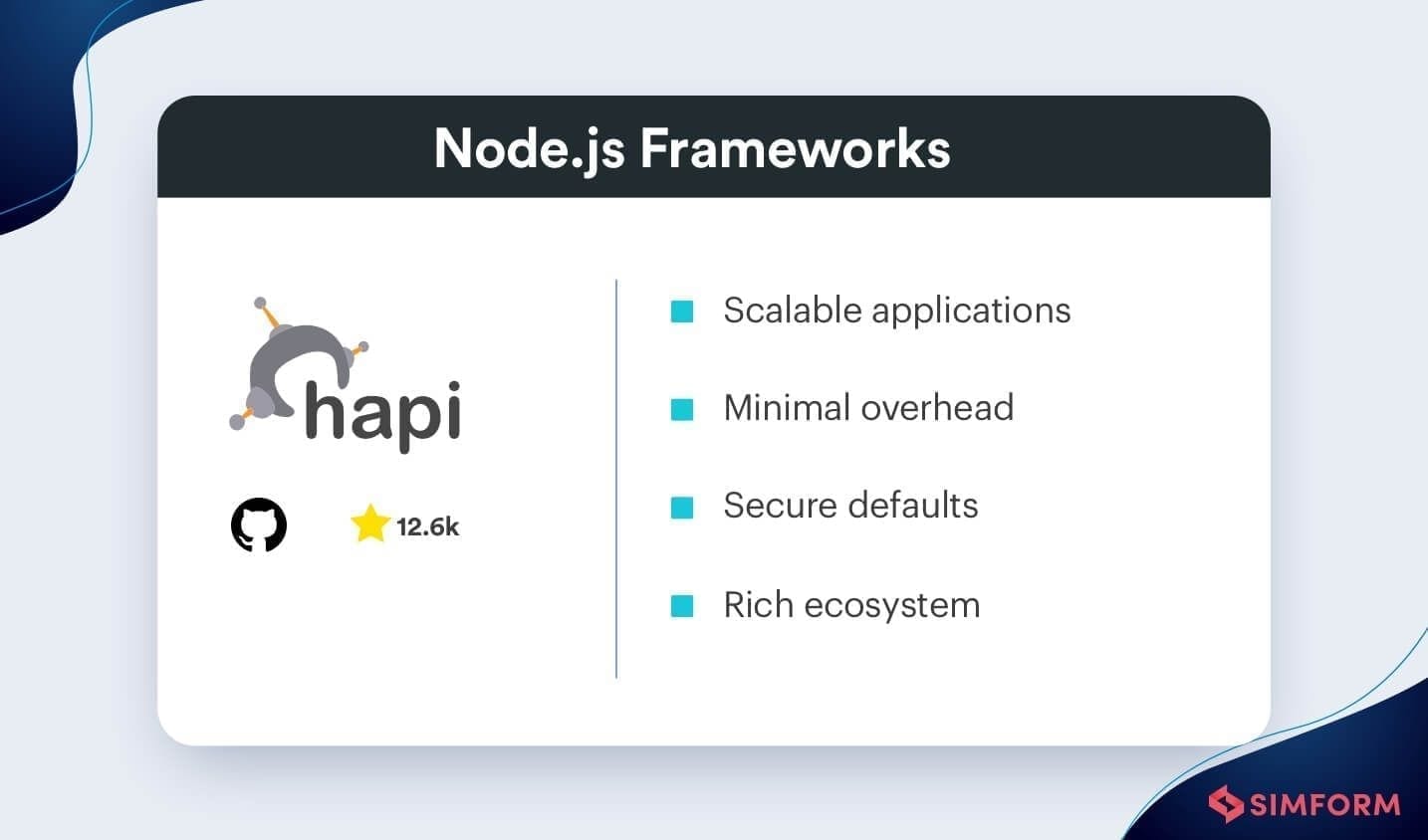
Hapi is a commercially available server and open-source framework for web applications. It is known for developing proxy servers, and REST APIs and other desktop applications since the framework is reliable and rich in its security aspects. It has a lavish set of built-in plugins, so you don’t have to worry about using unofficial middleware.
Features:
- Scalable applications
- Minimal overhead
- Secure defaults
- Rich ecosystem
- Fast & easy bug fixing
- Compatible with MySQL, MongoDB, and other databases
- Compatible with Rest APIs & HTTPS proxy apps
- Default caching, Authentication, and input validation
When to use Hapi.js
Hapi.js works like a charm in developing more secure, scalable, real-time, and social-media applications. Developers mostly use it to build proxies and API servers.
Feather.js– F for Flexible
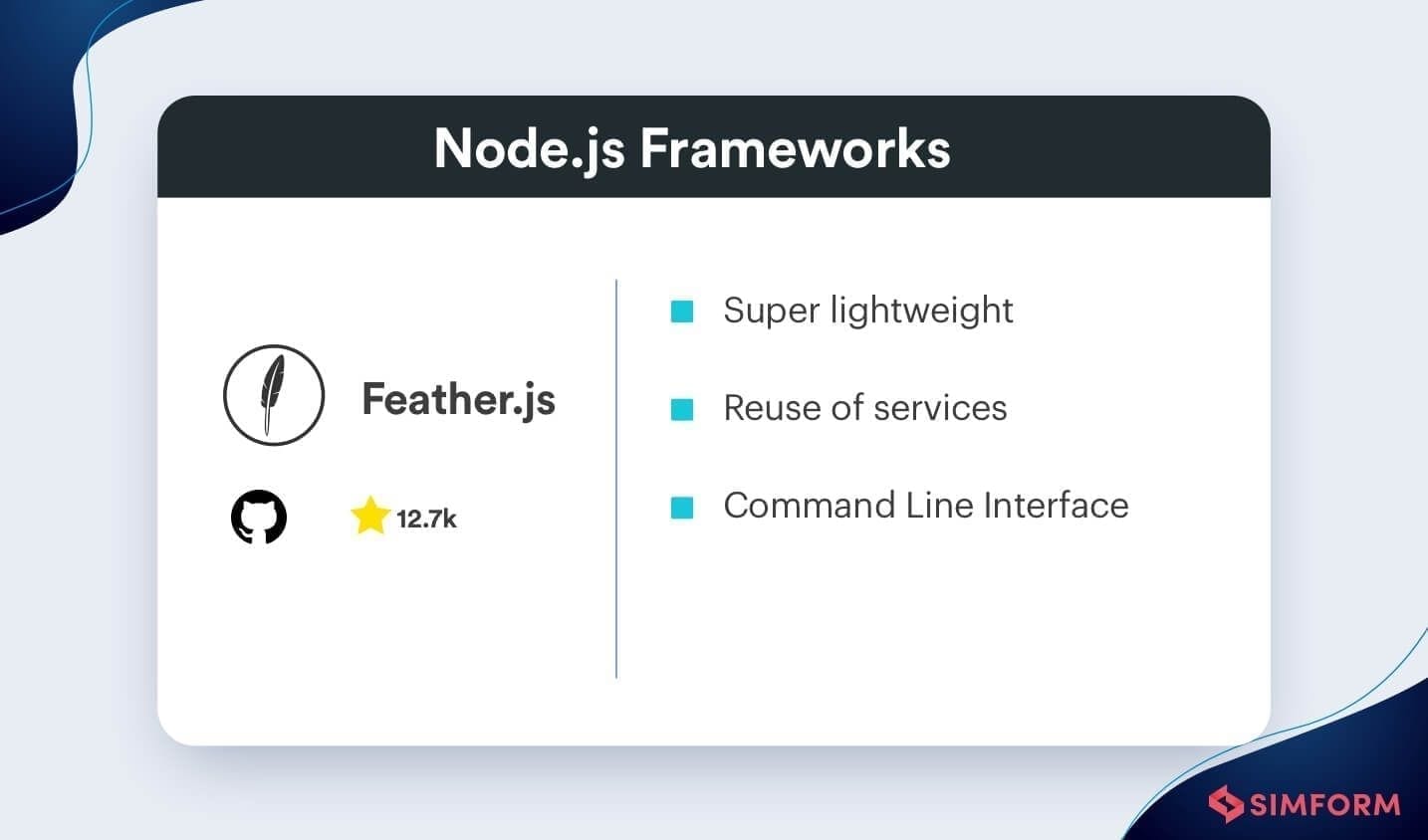
Feather.js is a popular Javascript framework for backend development providing flexibility with Node.js and ReactNative as well as on multiple databases. It is a Node.js-microservices framework with real-time functionality designed to simplify the modern web-app and mobile-app development.
It decodes the programming in a much more straightforward, intelligible manner, so developers need not get into the complexity of RESTful APIs. Feather makes it easier for developers to implement, connect, and communicate features for web apps.
Features:
- Super lightweight
- Reuse of services
- CLI
- Automatic RESTful APIs
- Default plugins for authentication and authorization
When to use Feather.js
The platform supports all frontend technologies, and its database agnostic works best with Node.js environment since the framework supports both Javascript and Typescript. It builds production-ready apps, real-time apps, and REST APIs all within a matter of days.
You can create a full-stack web app using services and hooks provided by the platform. Complex applications can be simplified and development time be reduced to a great extent using Feather.
Loopback.js- Better Connectivity
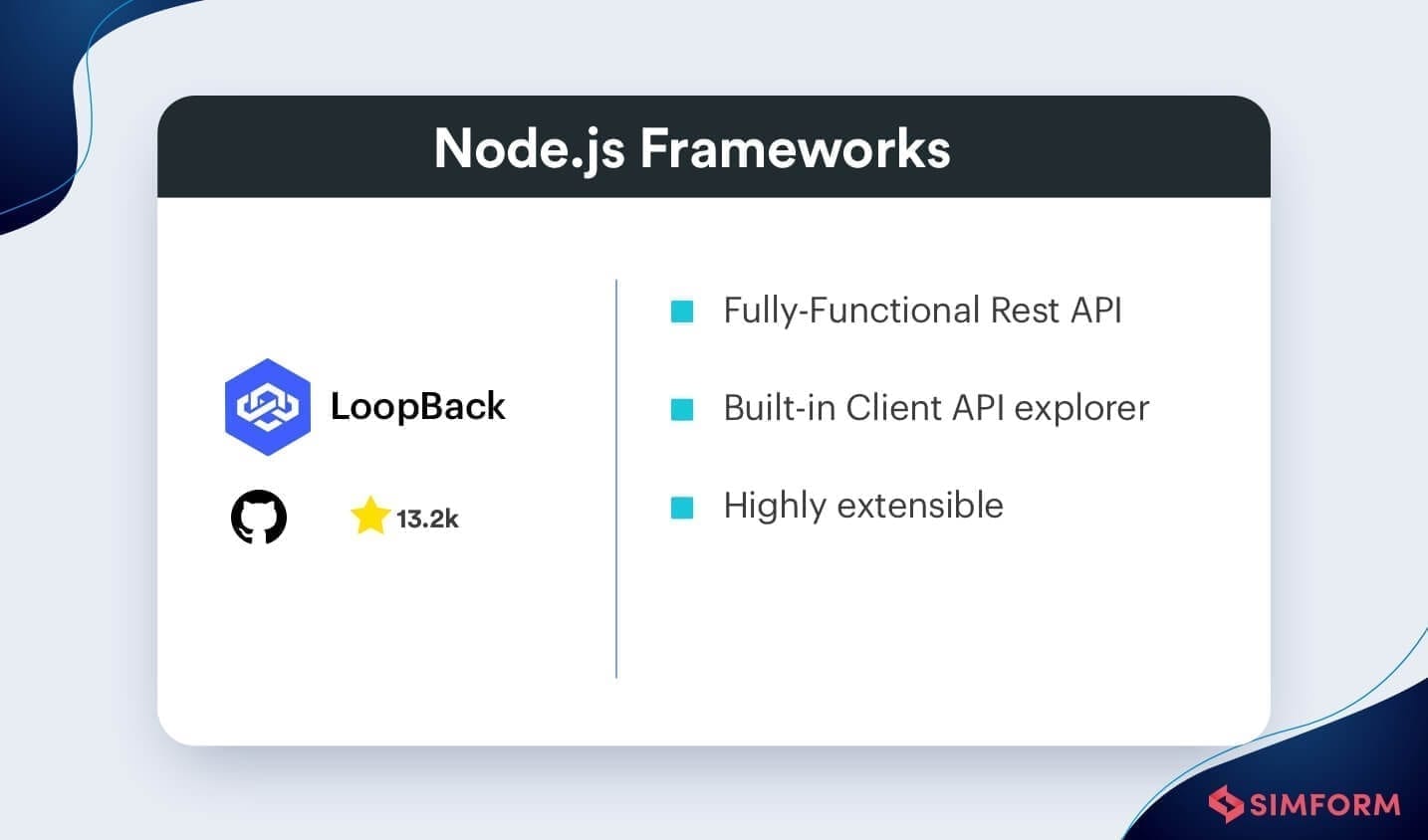
Last but not least, Loopback.js offers better connectivity with any Node.js framework, and you can integrate it with several different API services.The platform works best at creating REST APIs with minimal development time.
It provides excellent flexibility connecting with a wide range of devices, browsers, databases, and services. The structured code in the framework helps maintain app modules and development speed.
Loopback has better documentation that allows even novice developers to work with it.
Sapient, GoDaddy, Wizerg, and other tech companies have already reaped the benefits of Loopback, and it’s proving to be a brand-new, extensible framework for server-side apps.
Features:
- Fully-functional support for networked apps
- Built-in Client API explorer
- Highly extensible
- Multiple-database support
- Clean & modular codes
- Full-stack development
- Data storage, third-party access, and user management
When to use Loopback.js
Loopback is exclusive to building powerful end-to-end APIs and handling API requests. It can also be used as an external API service to accelerate the delivery of solutions, add security, authenticate, and more.
Adonis.js- The Dependable Framework
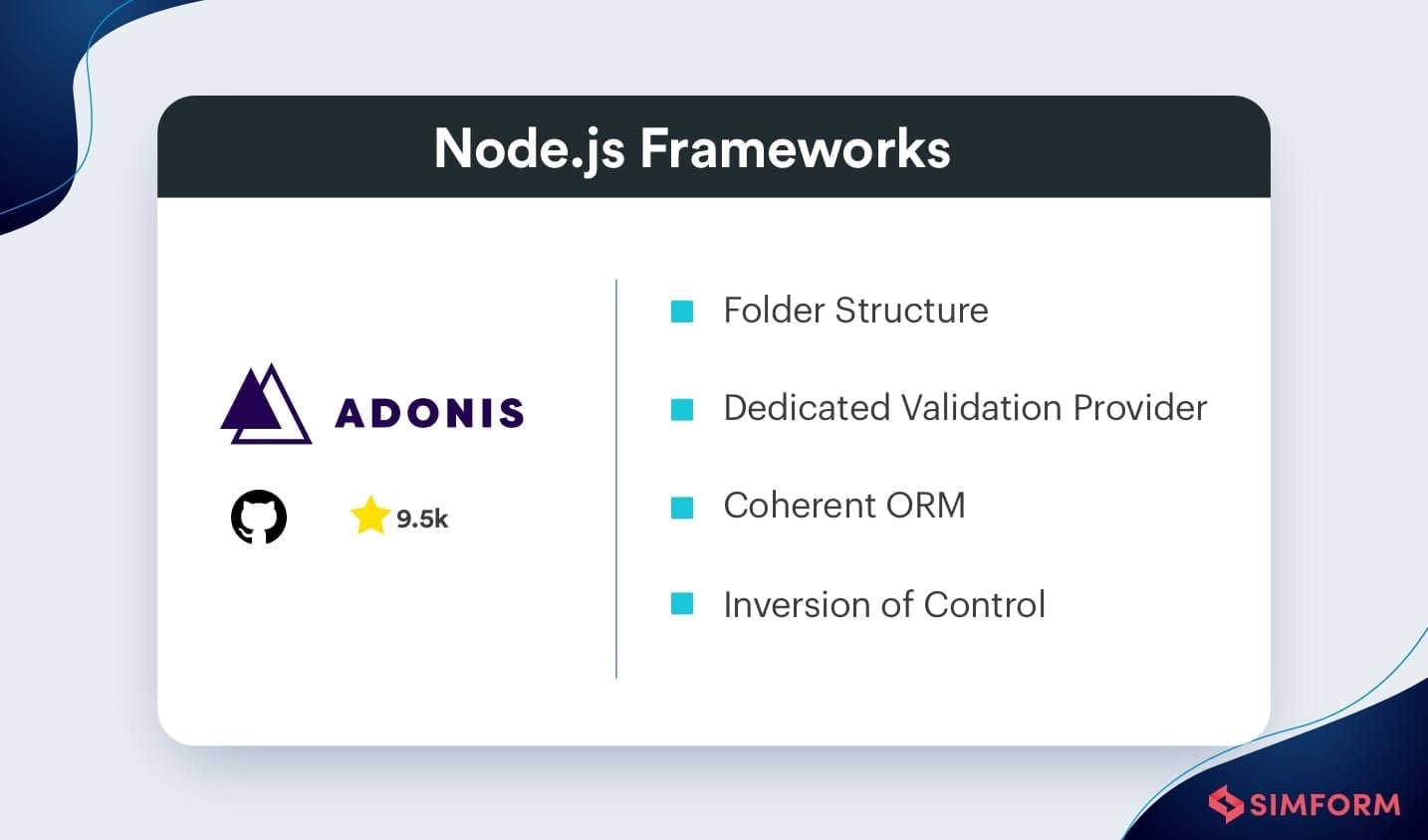
Adonis.js is an MVC Node.js framework based on a structural pattern that replicates Laravel. It reduces development time through focus on the essential development details like,
- Out of the box support for web socket
- Development speed and productivity
- Lifecycle Dependency Management
- Built-in modules for mailing, data validation, authentication, and Redis
The coding structure and command-based interface are easy to understand for developers. The Node.Js framework employs concepts of dependency injection through IOC or Inversion of Control. It offers an organized structure for developers to access all the components of the framework.
Features
- Organized Pattern with a folder structure
- Easier validation of user input.
- Service provider for lifecycle dependency management and IOC for DI(Dependency Injection)
- Facility to write custom functional test scripts
- Support for Lucid Object Relational Mapping.
- Protection against threats like cross-site forgery protection
When to use Adonis.js?
Adonis.js is suitable for developing faster web applications and web services that can return the JSON responses from a controller. It enables full-stack web app development with support for frontend technologies compatible with Node.js. So, if you are looking to develop a web application that is fast, interactive, and offers higher security, Adonis.js is quite suitable.
Derby.js- The Racer
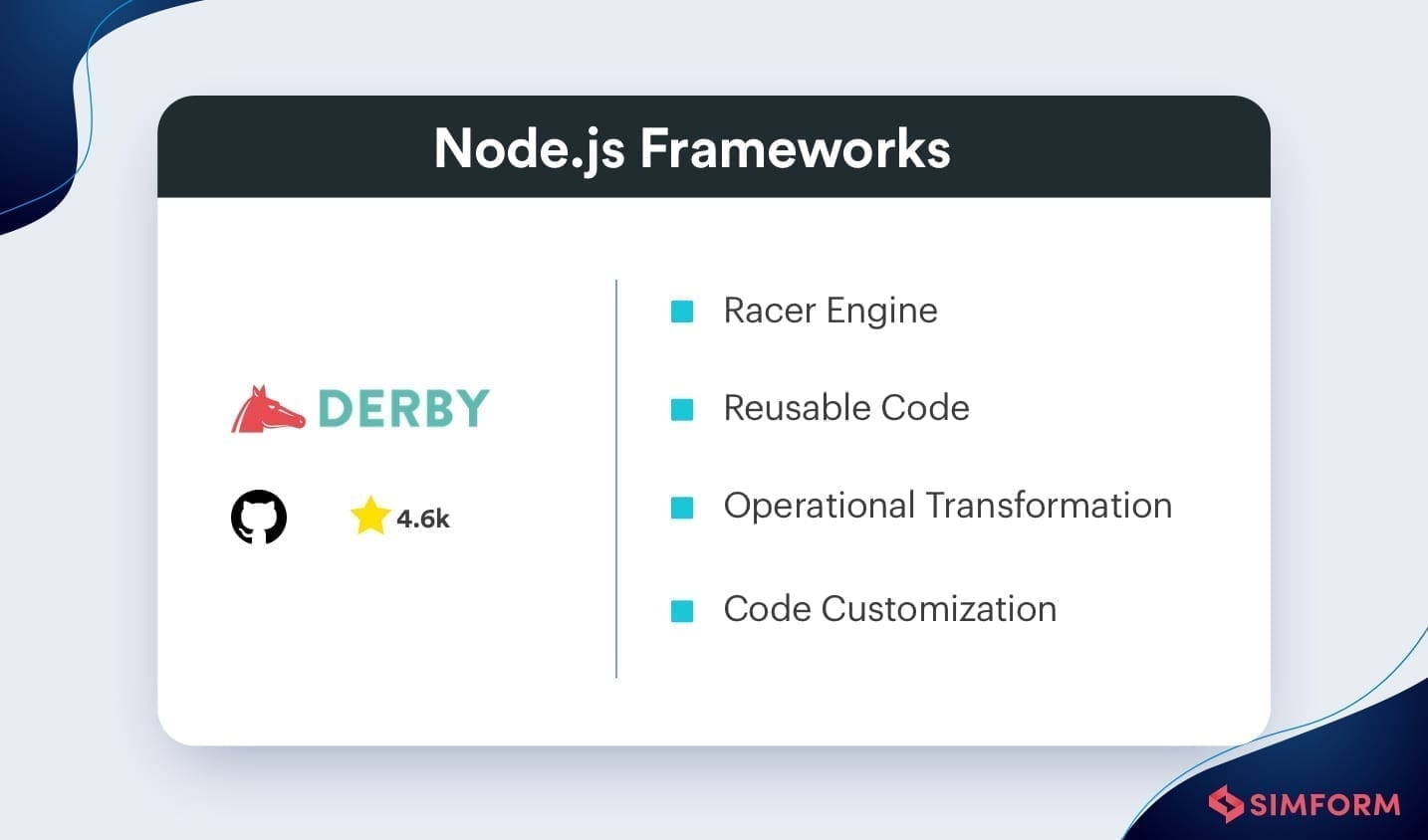
Derby.js is a full-stack web app development framework based on Node.js technology. It uses the MVC architecture with an easy to write coding nomenclature. The framework is an excellent choice for creating real-time apps because it allows the same code to run on Node.js (server) and the browser. So, you don’t need to worry about writing separate codes for the view part.
It uses the Racer engine to render real-time synchronization between the user, database, and app interface. The framework also supports offline usage for developers with a simplified scripting facility to write multi-user applications.
Derby.js reduces the delay in delivery of content through client-side view rendering on the server. This makes the application SEO-friendly and enhances the user experience.
Features
- Racer Engine support
- Operational transformation for data synchronization
- Support for offline usage and conflict resolution
- Code customizations
- Codesharing across client-side and server-side
- Renders client-side views on the server
When to use Derby.js?
Derby.js is best for developing a real-time chat web app. It offers real-time data synchronizations and faster content loading, making it the best choice for messaging app development.
Conclusion
With their immense capabilities at advancing web and mobile-apps development, Node.js frameworks make the developing apps effortless. With continually evolving technologies, scrutinizing our project requirement and resource availability is key in choosing the right framework that delivers the best results.
We hope that you’d be better informed and more confident now at choosing Node.js frameworks apt for the various needs in your future projects.
Still struggling in choosing the perfect Node.js framework? We’re here to help!
Also, don’t forget to pat yourself on the back on choosing Node.js as your backend platform…You’re looking at some biggies built with Node.js.
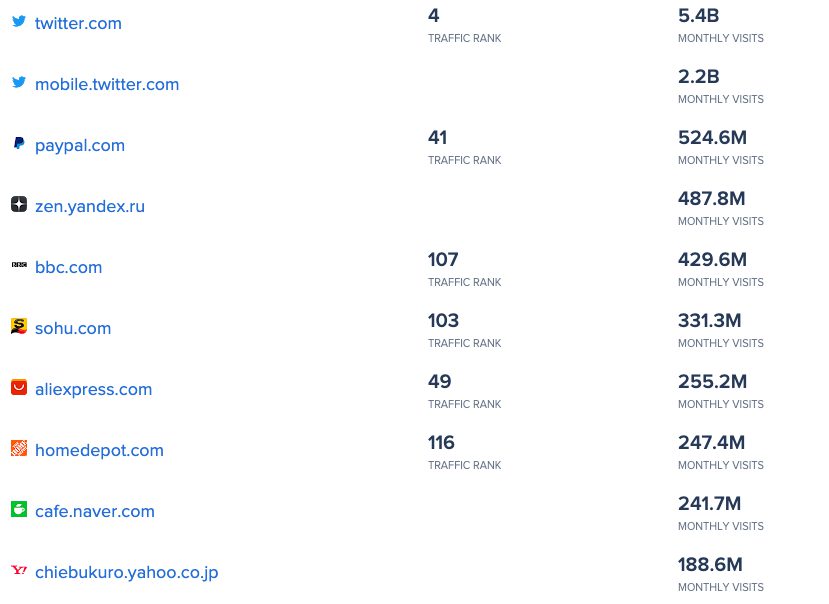
Please note the frameworks in this post are highlighted based on our personal experience, their popularity among Javascript community, and an overall success story of usage.
For a more detailed discussion on Node.js frameworks, drop me a line at tejas@simform.com.
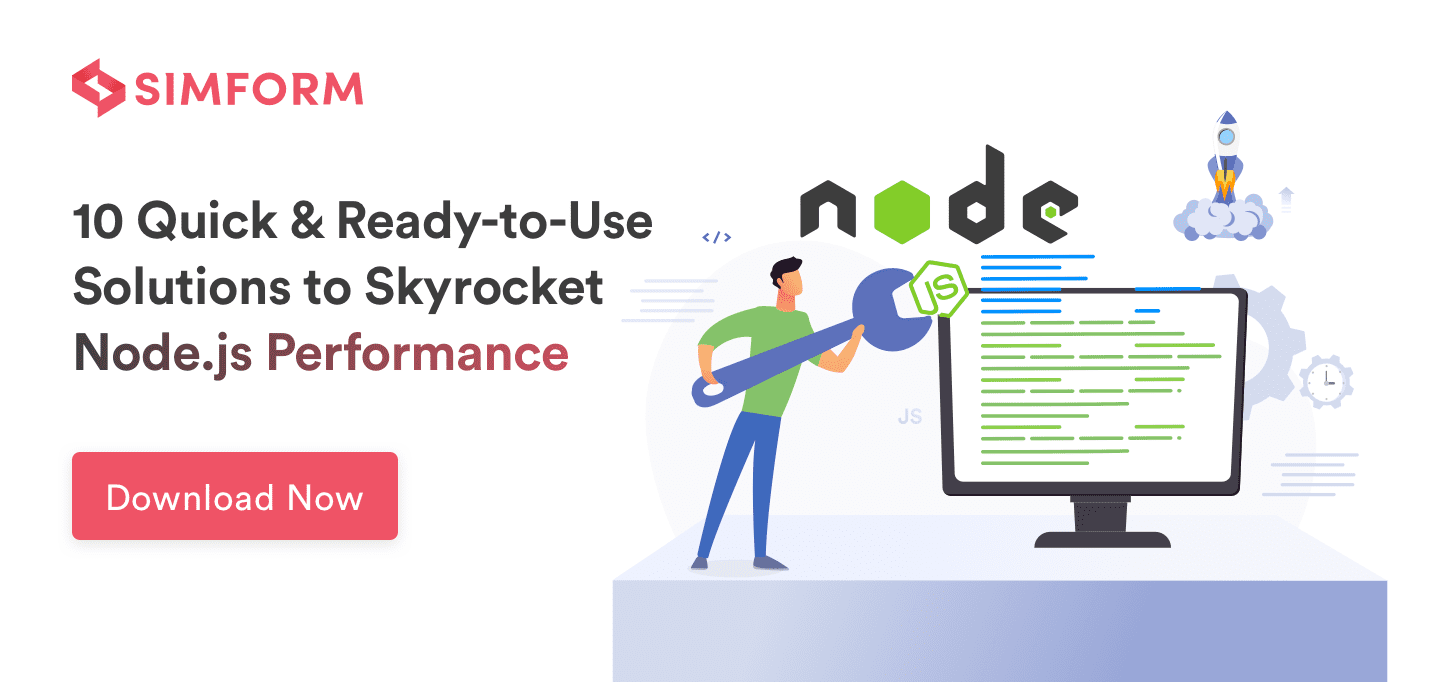

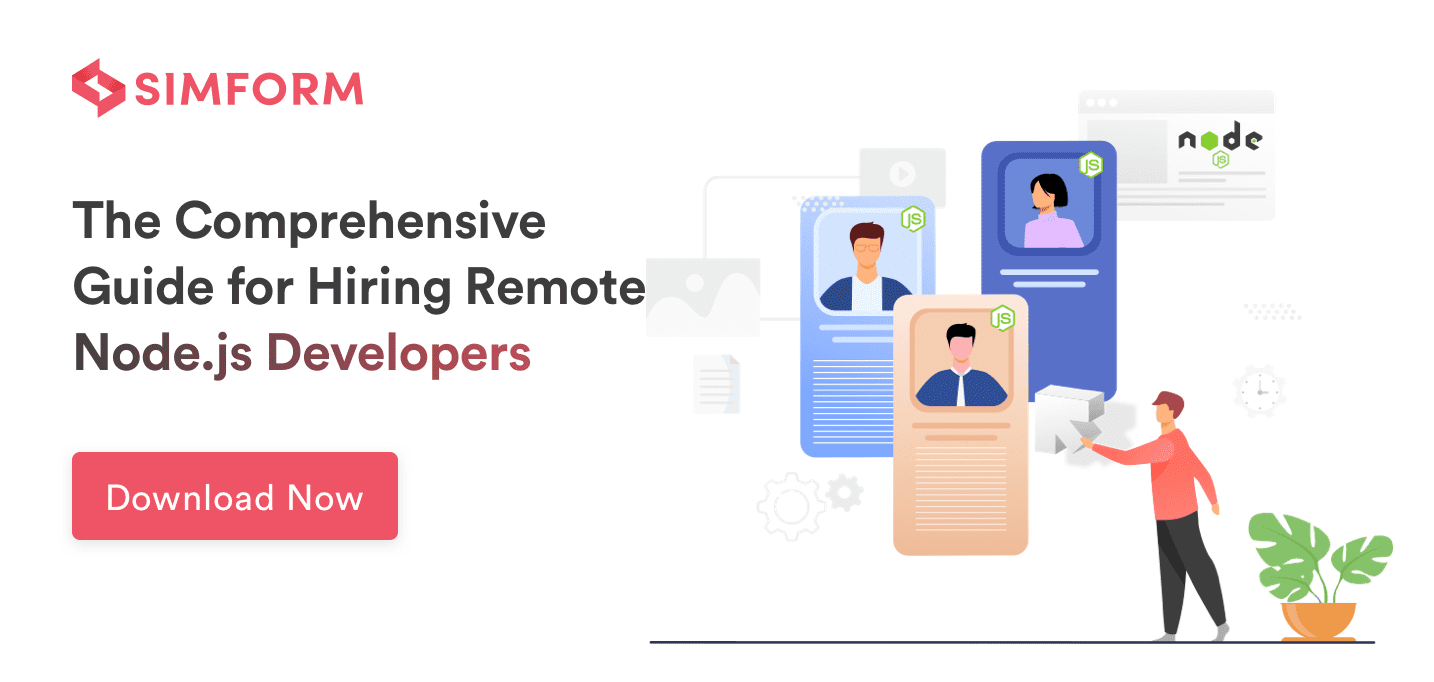
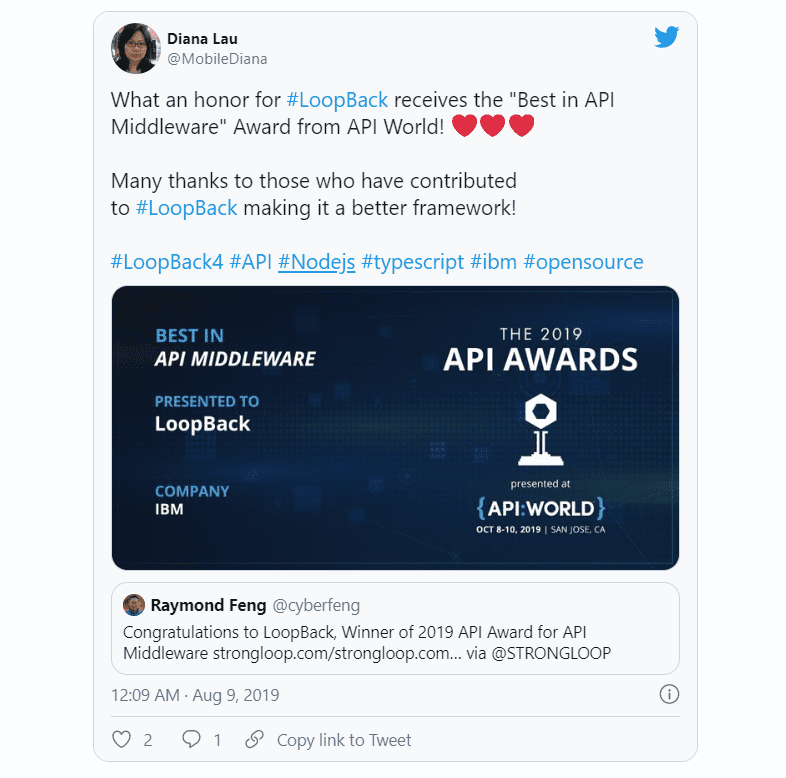
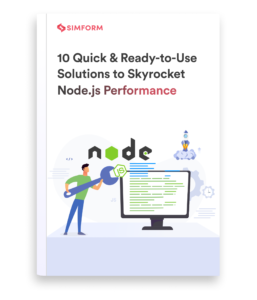
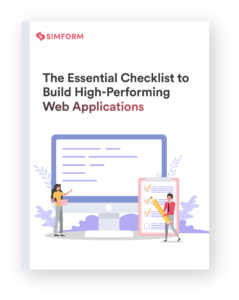
Mahesh
Thanks Mentioning if each framework is MVC/Fullstack-MVC/Rest-API or combination would have helped further
Rob Raisch
Interesting list, but without links to the various frameworks, it is of limited value.
MKG
Express JS has nothing to do with Web Frameworks. It is just a few libraries put together. Authentication and Database layers is required to call it Framework!
Sophie Mayer
I must say the author has put a lot of efforts in making this guide on best Node.js practices. Appreciating his/her efforts!